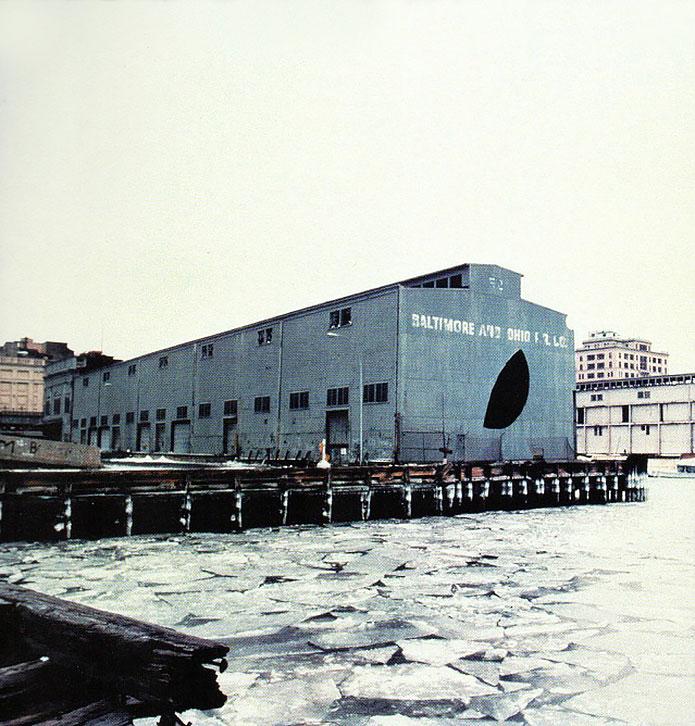David Hammons’s Empty Cathedral Echoes an Old New York
The public art installation in Hudson River Park will pay tribute to Matta-Clark’s iconic Day’s End and the commerce, crime, leisure and lovemaking of Manhattan's waterfront past
The public art installation in Hudson River Park will pay tribute to Matta-Clark’s iconic Day’s End and the commerce, crime, leisure and lovemaking of Manhattan's waterfront past

Setting out at dawn, I bike past Brooklyn Navy Yard, away from the Walt Whitman Houses, and build a head of steam crossing into Manhattan by bridge. As I drop into Lower Manhattan, new trails and parkland reclaimed from docklands allow me to thread a circuitous route to the Hudson River, where I pass a number of ghost piers interspersed between gentrified green space until I reach Pier 52, a location marked only on a virtual map I have been using. All that is visible next to the Gansevoort Peninsula is a row of seven pylons jutting out of the sea. Have I reached David Hammons’s Day’s End (2021)?
I spot an elderly gentleman leaning on the fence, gazing into the same expanse of the river as I am, and I decide to chance an encounter. From a two-metre distance, I greet him and ask through my mask what he thinks will be going up here. Startled, he takes a beat before replying, with a twinkle: ‘I have no idea but, just going by what you see, it’s going to be fabulous.’

Although Hammons’s Day’s End remains, at present, little more than a glimmer in this man’s eye, the artist’s rendering and some architectural drawings suggest a monument that will be grand indeed. As a conceptualist, Hammons is a fabulist in the sense philosopher Gilles Deleuze intended when he wrote, in Essays Critical and Clinical (1993), of someone who exhibits ‘a tendency to project – into things, into reality, into the future and even into the sky – an image of himself and others so intense that it has a life of its own.’ Day’s End will be, among other things, a tribute to the mixed uses of the Manhattan waterfront over the decades: commerce and crime, leisure and lovemaking, art and speculation. Projected to be a floating outline of the type of warehouse structure that once dotted the West Side – structures that lay in various states of dereliction by the 1970s, when artists like Gordon Matta-Clark imagined one as a site of sculptural intervention – Hammons’s public artwork will be installed next to what is today a sanitized and upscaled Meatpacking District.
Given its touristic location, Day’s End may risk being misread as the latest folly in the garden of postmodern urbanism – like Thomas Heatherwick’s viewing platform Vessel (2019), in nearby Hudson Yards, only without the risk of falling. But the floating simplicity, even austerity, of Hammons’s design cautions such easy conflations. Like his early performance piece selling snowballs on a sunny day (Bliz-aard Ball Sale, 1983), there is something of the ephemeral in Day’s End, even in its solidity.

The namesake for Hammons’s piece is Matta-Clark’s Day’s End (1975), in which the latter artist cut through the floors, walls and ceiling of Pier 52 in order to create what has frequently been referred to as a ‘cathedral’. In his memoir Before Pictures (2016), the late historian Douglas Crimp noted how Matta-Clark used to lock Pier 52 while he was working on the installation, perhaps hoping to dissociate his art from the cruising for sex that gay men used to do in the space during that period. Black gay photographer Alvin Baltrop documented the sex scene on the piers assiduously over the years, including inside Matta-Clark’s Day’s End, and his images come down to us as part of the transgressive legacy to which Hammons’s new structure of steel and light will, in part, pay tribute.
Matta-Clark’s cathedral was built at a low point in the wealth cycle of the Hudson River waterfront, playing a role – albeit unwittingly – in what has consequently been identified as the artist-led gentrification of post-industrial cities. Hammons’s new work arrives post-pandemic, burdened by a newer question: can art ever play a role in the depreciation of capital’s power over the city? Here it might be read in relation to another, otherwise dissimilar, work of art: Kara Walker’s temporary monument, A Subtlety, or the Marvellous Sugar Baby (2014), on the site of the former Domino’s Sugar Refinery on the Brooklyn waterfront in Williamsburg. Yet, whereas Walker’s pornotroping of the Black female body makes the racial history of sweetness and power unmistakable, the black conceptualism of Hammons’s Day’s End gives us no surface onto which to project a racial epidermal schema. What it does place front and centre is an image of an ecological future in which New York is already partially submerged and the liquidity of capital markets has ceded to a more fundamental sense of fluidity and flux. If Matta-Clark’s installation was an offering to the past as he romanticized it, Hammons seems to greet a future that can only be contemplated with some unease. After all, to enter Hammons’s cathedral, you’ll have to walk on water.
David Hammons's Day's End will be unveiled to the public May 2021.
This essay is part of a series on public art. It will appear in the May issue of frieze.
Main image: Rendering of the proposed project, Day’s End by David Hammons, as seen from the south. Courtesy Guy Nordenson and Associates.






















